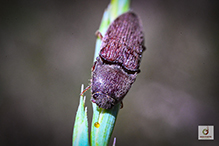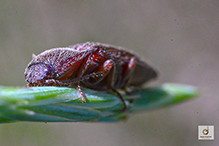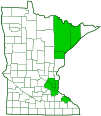chestnut-footed click beetle
(Melanotus castanipes)
Conservation • Description • Habitat • Ecology • Distribution • Taxonomy
|
|
||||||||||||||
Description |
Chestnut-footed click beetle is a large native beetle. It occurs in Europe, eastern Asia, and North America. In the United States it occurs from Maine to Maryland, west to Minnesota and Illinois. There is a disjunct (separated) population in Utah, Colorado, northern Arizona, and northern New Mexico, and it has been collected in southern California. There are also several unverified observations in the south. It occurs across southern Canada from Nova Scotia to Manitoba. Adults are active from late April to mid-July. They are found in the spring and summer both during the day and at night on flowers and vegetation. In the winter they are found under bark. The larvae are called wireworms. They live in the soil and feed on the sprouting seeds and roots of young grasses. Adults are ⅝″ to ¾″ (15 to 20 mm) in length. The body is long and somewhat flattened. The color has been described in the literature as “brownish piceous,” “reddish to dark reddish brown,” “black,” and “uniformly black.” It is moderately and evenly covered with yellowish hairs. The surface of the upper part of the front of the head, corresponding to the forehead, is coarsely punctured (punctate). Most of these punctures are hexagonal, and they are separated by less than half their diameter. There is often a shallow depression in the middle of the frons (the upper part of the front of the head). The antennae are inserted close to the eyes and have 11 segments. Segment 1 is long and cylindrical, while segment 2 is spherical. Both segments 2 and 3 are small, much smaller than segment 4. Segments 4 through 7 are triangular. The frontal margin (lower edge of the frons) is not strongly produced forward. It does not project over the nasale (the area between the antennae bases). The pronotum (the plate on the first segment of the thorax) is wider than long. The rear corners are extended into a rearward-pointing angle. The surface of the pronotum is coarsely punctate. The punctures are mostly oval, but they are similar in size to those on the frons. They are more widely spaced in the center, separated by a distance equal to the diameter of the puncture or slightly less. The punctures on the rear angles are hexagonal. Each elytron (wing cover) has 9 rows of punctured grooves. On each leg, there is a spur at the tip of the tibia (the fourth leg segment). The tarsus (the last part of each leg, corresponding to the foot) has 5 segments. The tarsal segments do not have lobes on the underside. The last segment has 2 claws at the tip. The claws are pectinate (have short, comb-like teeth). |
Size |
Total length: ⅝″ to ¾″ (15 to 20 mm) |
Similar Species |
Habitat |
|
Ecology |
Season |
Late April to mid-July |
Behavior |
Adults are attracted to lights |
Life Cycle |
|
Larva Food |
Sprouting seeds and roots of young grasses |
Adult Food |
|
Distribution |
||
|
Sources Quate, Laurence W. and Thompson, Sarah E. 1967. "Revision of Click Beetles of Genus Melanotus in America North of Mexico (Coleoptera: Elateridae)." Proceedings of the United States National Museum, 121, (3568) 1–83, 12 figures, 1 plate. https://doi.org/10.5479/si.00963801.121-3568.1 |
|
| 7/5/2025 | ||
Occurrence |
||
|
||
Taxonomy |
|
Order |
Coleoptera (Beetles) |
Suborder |
Polyphaga (Water, Rove, Scarab, Long-horned, Leaf, and Snout Beetles) |
Infraorder |
Elateriformia |
Superfamily |
Elateroidea (Click, Firefly, and Soldier Beetles) |
Family |
|
Subfamily |
Elaterinae |
Tribe |
Melanotini |
Genus |
Melanotus |
Subordinate Taxa |
|
|
|
Synonyms |
|
Cratonychus inaequalis Cratonychus scrobicollis Elater castanipes Melanotus paradoxus Melanotus texanus |
|
Common Names |
|
chestnut-footed click beetle |
|
Glossary
Frons
The upper front part of an insect’s face, roughly corresponding to the forehead.
Pronotum
The exoskeletal plate on the upper side of the first segment of the thorax of an insect.
Punctate
Dotted with pits (punctures), translucent sunken glands, or colored spots of pigment.
Tarsus
On insects, the last two to five subdivisions of the leg, attached to the tibia; the foot. On spiders, the last segment of the leg. Plural: tarsi.
Tibia
The fourth segment of an insect leg, after the femur and before the tarsus (foot). The fifth segment of a spider leg or palp. Plural: tibiae.
Visitor Photos |
||
Share your photo of this insect. |
||
This button not working for you? |
||
Mike Poeppe |
||
 |
 |
|
MinnesotaSeasons.com Photos |
||
|
||
|
||

Visitor Videos |
||
Share your video of this insect. |
||
This button not working for you? |
||
|
Other Videos |
||
Melanotus castanipes - Lyngby Denmark 17 september 2014 |
About
Sep 17, 2014 |

|
Created: 7/5/2025 Last Updated: © MinnesotaSeasons.com. All rights reserved. |




